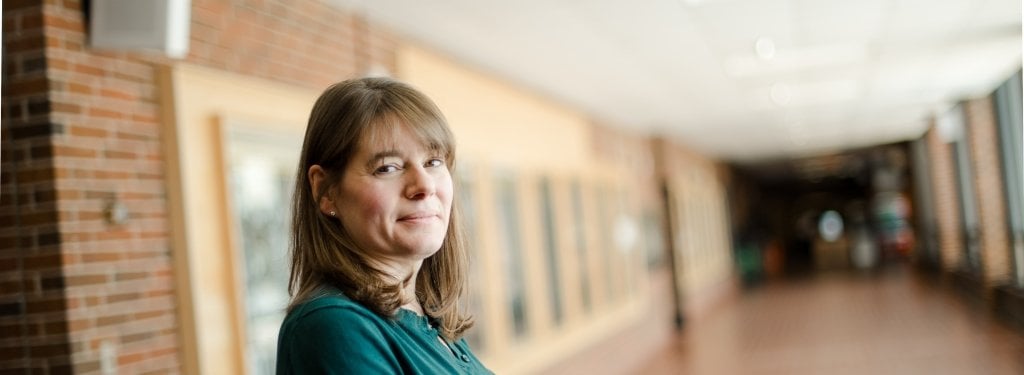Small populations in rural areas of the Upper Peninsula mean big gaps in state health care data. Kelly Kamm’s research on infant feeding seeks to bridge those gaps.
What do Beyonce, Gisele Bündchen, Mila Kunis and Blake Lively have in common? Fame and fortune, check. Breastfeeding their babies, check.
Considering these celebrities' public endorsement of breastfeeding, it might seem like breastfeeding is popular in the United States. But that's not the case. According to the Center for Disease Control and Prevention (CDC), that has been trying to raise the national rate of women breastfeeding, race and socioeconomics heavily influence if a woman ever breastfeeds. The numbers are even lower for women who breastfeed for six months and longer.
Kelly Kamm, research assistant professor in the Department of Kinesiology and Integrative Physiology is unsatisfied by the CDC's statistics. She hopes to better understand how families feed infants in the UP.
"The question 'have you ever breastfed' means, to some extent, did somebody try in the hospital, but it's not really a good metric of what's going on in the UP. We're such a small percentage of the population, any state or national data doesn't actually survey anybody up here, so there's really not much known about what's going on."
Small Population, Big Gap
Backed by a Portage Health Foundation and a Michigan Tech Research Excellence Fund (REF) grant, her background in maternal and child health, along with her personal experience as a mother, Kamm is asking UP health care providers and mothers with children under the age of five to complete anonymous surveys. She's looking for women with kids under five to include respondents who are done with breastfeeding and to learn what did they, when they stopped feeding and why and how long they breastfed.
She's hoping to get a large number of participants from all across the UP and is also surveying and speaking with health practitioners. Her questions ask about the breastfeeding support, if any, practitioners provide to new mothers. She understands that time and resources vary from practitioner to practitioner and county hospital to county hospital, which is likely to impact the number of new moms who take up and stick with breastfeeding their babies. But these are all hypotheses, and without the data, all Kamm can do is speculate—which is happening anyway, since UP families are not surveyed for national and regional datasets. More data will help explain what's different or lacking in systems up here compared to larger scale trends.
The current national rate of delivery by cesarean (or c-section) is 31.9 percent. But more mothers delivering by c-section, likely influences the number of women who breastfeed. The process can make breastfeeding more difficult, "you've got an incision that's more uncomfortable ... Your recovery can be a lot longer and so it can be harder to breastfeed; if there's reason for c-sections that are different from the rest of the country or state that would be interesting to know,” Kamm says. Kamm is hoping to recruit participants from every county in the UP and be able to share out specific data, as opposed to more general, UP-wide data.
There’s Sisu in Numbers
As an epidemiologist, Kamm studies disease control and prevention. After doing fieldwork in Bangladesh and Kenya, she is passionate about enacting community-based prevention programs. For UP mothers, Kamm thinks a peer-to-peer model between new mothers will encourage and support women to start and continue breastfeeding their babies. Kamm says that her overarching goal after data collection and analysis is to, "work with UP communities to develop different interventions to improve both initiation and duration of breastfeeding."
Kamm is pleased by the support she is receiving from UP moms: "I've had quite a few moms call me and send me messages, which is great because I felt coming up here to the land of engineers that I'm the weird one doing this research and so it's great to see from the community perspective. I am getting calls saying 'thank you for doing this,' 'this is great,' 'can we do more?'"
Doing more is exactly what Kamm hopes to do. Over the summer she’ll analyze her datasets and work on dissemination. She plans to share her findings in ways that will directly benefit UP medical professionals working with mothers with infants and small children. More support for breastfeeding benefits both mother and baby, making UP residents healthier and happier.
Michigan Technological University is an R1 public research university founded in 1885 in Houghton, and is home to nearly 7,500 students from more than 60 countries around the world. Consistently ranked among the best universities in the country for return on investment, Michigan's flagship technological university offers more than 120 undergraduate and graduate degree programs in science and technology, engineering, computing, forestry, business, health professions, humanities, mathematics, social sciences, and the arts. The rural campus is situated just miles from Lake Superior in Michigan's Upper Peninsula, offering year-round opportunities for outdoor adventure.






Comments